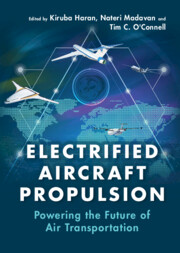Book contents
- Electrified Aircraft Propulsion
- Electrified Aircraft Propulsion
- Copyright page
- Dedication
- Contents
- Contributors
- Preface
- 1 Benefits of Electrified Propulsion for Large Aircraft
- 2 Aircraft Electric Power System Design, Control, and Protection
- 3 Megawatt-Scale Electric Machines for Electrified Aircraft Propulsion
- 4 Superconducting Machines and Cables
- 5 Conventional Power Electronics for Electrified Aircraft Propulsion
- 6 Cryogenic Power Electronics
- 7 Electrochemical Energy Storage and Conversion for Electrified Aircraft
- 8 Thermal Management of Electrified Propulsion Systems
- 9 Performance Assessment of Electrified Aircraft
- Index
- References
6 - Cryogenic Power Electronics
Published online by Cambridge University Press: 11 May 2022
- Electrified Aircraft Propulsion
- Electrified Aircraft Propulsion
- Copyright page
- Dedication
- Contents
- Contributors
- Preface
- 1 Benefits of Electrified Propulsion for Large Aircraft
- 2 Aircraft Electric Power System Design, Control, and Protection
- 3 Megawatt-Scale Electric Machines for Electrified Aircraft Propulsion
- 4 Superconducting Machines and Cables
- 5 Conventional Power Electronics for Electrified Aircraft Propulsion
- 6 Cryogenic Power Electronics
- 7 Electrochemical Energy Storage and Conversion for Electrified Aircraft
- 8 Thermal Management of Electrified Propulsion Systems
- 9 Performance Assessment of Electrified Aircraft
- Index
- References
Summary
Cryogenic power electronics enable the highly efficient ultra-dense power conversion systems that are critical for electrified aircraft propulsion (EAP) and have the potential to transform aircraft powertrain design. Much like superconducting electric machines, cryogenic power electronics offer benefits achieved through improved power device performance, reduced conductor electrical resistivity, and increased heat transfer temperature differential. In this chapter, key steps in the development of cryogenic power electronics are presented, from the component to the converter level. First, the characterization of critical components – including power devices and magnetics – at cryogenic temperature is introduced to establish the basic knowledge necessary for cryogenic design and optimization. Second, special considerations specific to cryogenic design, and trade and design studies for the cryogenic power stage and filter electronics are detailed. Finally, an example of a high-power cryogenically-cooled inverter system for an EAP application is illustrated, with safety considerations and the protection scheme highlighted.
Keywords
- Type
- Chapter
- Information
- Electrified Aircraft PropulsionPowering the Future of Air Transportation, pp. 150 - 189Publisher: Cambridge University PressPrint publication year: 2022



